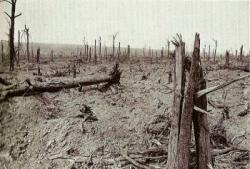
Published date
15 July 1916
South Africa entered WWI on 8 September 1914, on the side of the Allied Forces. On 15 July 1916, the S.A. Infantry Brigade under Major-General H.T. Lukin was ordered to clear the wood at d'Elville, north-east of the village of Longueal, France, of enemy soldiers, thereby covering the flanks of the British Brigade. The South Africans occupied the wood on that day, but the problem was not so much to take the wood, than to hold it. Despite fierce counterattacks and artillery bombardments from German divisions, the SA brigade refused to surrender. The brigade was relieved on 20 July after six days and five nights of ferocious fighting. Only 750 soldiers remained of the Brigade's 3 433 soldiers, the rest had either been killed or wounded. Black people were also involved in this battle as unarmed combatants and non-military personnel. The Battle of Delville Wood went down in the history of WWI as an example of supreme sacrifice and heroism and remained the most costly action the South African Brigade fought on the Western Front. A memorial site was erected in remembrance of those who died in the Battle and was unveiled by the widow of General Louis Botha on 10 October 1926. 146 000 Whites volunteered for service in WW1, while altogether 83 000 Blacks and 2 000 Coloureds did service in non-combatant capacity.
References
Liebenberg, B.J. & Spies, S.B. (eds)(1993). South Africa in the 20th Century, Pretoria: Van Schaik Academic, p. 115.|
Potgieter, D.J. (ed)(1971) Standard Encyclopedia of Southern Africa Vol. 3, Cape Town: Nasou, p. 638.|
Reader's Digest. (1988).Illustrated History of South Africa: the real story, New York: Reader's Digest Association, p. 303.|